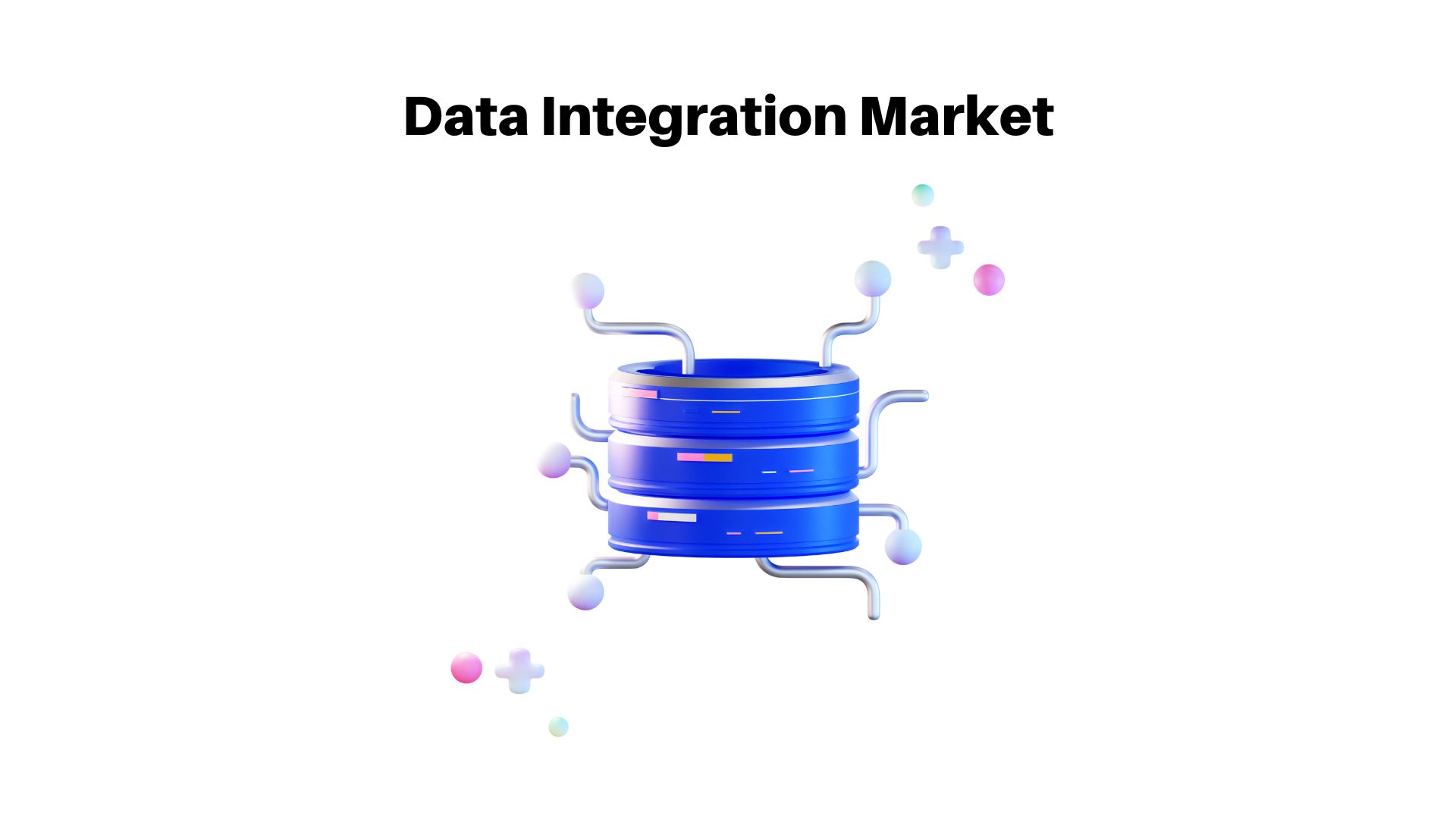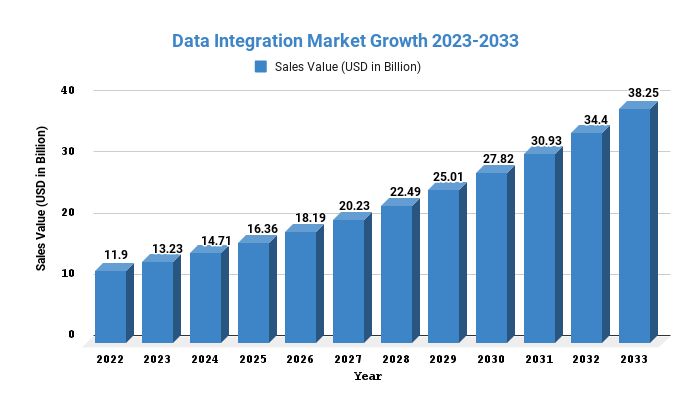Data Integration Market Will Reach USD 38.25 Billion By 2033

Page Contents
Market Overview
Published Via 11Press:
Hybrid data integration is becoming more popular
For the reason it permits applications data files and business partners to be connected over cloud and on premises systems hybrid data integration is a popular tool. Hybrid data is used for data integration because it focuses primarily on the deployment model element. Data integration is a key network and data transfer solution. Data integration software is used to protect the data and make it secure every year.
Data integration compliance is becoming more stringent
A data integration compliance program is a set of regulations that financial institutions large and small businesses also medium sized enterprises must adhere to in order to prevent data loss. Due to the data security threats connected with data transfer the government and other authorities are compelled to raise regulations on data integration.
Software and data integration tools are in high demand
Data lakes which are tools that allow data integration to be used for real time analytics or fraud detection are examples. Modern cloud based services integrate data to provide data visualization and reporting. These tools authorize for real time analysis of transactions to detect fraud and send notifications.
Application-based integration is in high demand
Data integration systems have become increasingly dependent on application-based integration. Banking, IT & Telecom and manufacturing as well as media, entertainment, media and retail prefer to use application-based integration in order to monitor suspicious transactions or financial crimes. Application integration software allows data to flow between two different software applications. Application integration software is often used by businesses to connect an older cloud application with a newer, on-premise application. This allows for a variety of applications to work together.
Data Integration Market projected to reach USD 38.25 Billion in 2033 and growing at a CAGR of 11.20% for the forecast year 2022-2033.

Key Takeaways
- The data integration market has been expanding significantly in recent years driven by the increasing volume and complexity of data generated by organizations. The market includes a wide range of vendors, from established software giants to newer startups offering cloud-based solutions.
- The increasing demand for advanced analytics, data warehousing and cloud computing technologies is driving the growth of the market. The cloud-based deployment mode is expected to dominate the market due to its flexibility, scalability and cost effectiveness.
- The healthcare, banking, financial services and insurance (BFSI) and retail sectors are expected to be the major end-users of data integration solutions due to the growing need for real-time data integration and analysis.
- North America is expected to dominate the data integration market due to the presence of major market players and the adoption of advanced technologies by organizations.
Request For Sample Report Here: https://marketresearch.biz/report/data-integration-market/request-sample/
Regional Snapshot
- North America: North America is the largest market driven by the expanding adoption of cloud-based solutions, the presence of several key players in the region and the enlarging demand for advanced analytics. The United States is the major contributor to the market growth in North America due to the significant adoption of data integration solutions across various industries.
- Europe: Europe is another outstanding market for data integration solutions driven by the growing demand for cloud-based solutions, the growing assumption of IoT and the need to comply with various regulations related to data privacy and security. The United Kingdom, Germany and France are the major contributors to the market growth in Europe.
- Asia-Pacific: The Asia-Pacific region is expected to witness significant growth in the market due to the growing adoption of cloud-based solutions, the increasing focus on data-driven decision making and the rapid growth of the e-commerce industry in the region. China, India and Japan are the major contributors to the market growth in the Asia-Pacific region.
- Latin America: The Latin American market is anticipated to witness steady growth because of the expanding adoption of cloud based solutions and the enlarging demand for advanced analytics. Brazil and Mexico are the major contributors to the market growth in Latin America.
- Middle East and Africa: The Middle East and Africa region is anticipated to witness outstanding growth in the data integration market due to the expanding adoption of cloud-based solutions, the growing demand for advanced analytics and the increasing focus on digital transformation. The major contributors to the market growth in this region include the United Arab Emirates, Saudi Arabia and South Africa.
Ensure everything is in line with your specific requirements here: Ensure everything is in line with your specific requirements here: https://marketresearch.biz/report/data-integration-market/#inquiry
Drivers
- Increasing volume and variety of data: With the rise of big data, organizations are generating and collecting vast amounts of data from various sources such as social media, IoT devices and enterprise applications. Data integration tools help organizations to collect, process, and analyze this data to gain insights and make informed business decisions.
- Growing demand for cloud-based solutions: As more organizations move their data and applications to the cloud there is an increasing need for data integration tools that can seamlessly integrate data across cloud and on premises environments.
- Need for real-time data integration: In today's fast paced business environment, organizations need access to real-time data to make informed decisions. Data integration tools that can provide real-time data integration are in high demand.
- Increase in the adoption of AI and ML technologies: Artificial intelligence and machine learning technologies are being broadly adopted across industries to improve decision making and automate processes. Data integration tools that can integrate data from multiple sources and provide a unified view of data are critical for the success of AI and ML projects.
- Focus on data governance and compliance: With the increasing focus on data governance and compliance organizations are looking for data integration tools that can ensure data accuracy consistency and security across all data sources. Data integration tools that can provide robust data governance features are in high demand.
Restraints
- Complex data environments: With the growth of big data, companies have to deal with a complex and diverse range of data sources. This complexity can lead to challenges in integrating data from different sources.
- Security and compliance concerns: With the increasing importance of data privacy, security and compliance regulations, companies have to ensure that their data integration processes comply with these regulations. Failure to comply with these regulations can result in hefty fines and damage to reputation.
- High cost of integration: It can be a costly process, requiring significant investments in infrastructure, tools and personnel. The high cost can make it challenging for smaller companies to implement data integration solutions.
- Resistance to change: Some companies may resist changing their existing data integration processes even if they are outdated or inefficient. This resistance can prevent the adoption of new more efficient data integration solutions.
- Lack of skilled personnel: The data integration market requires skilled personnel who can design and implement data integration solutions. However, there is a shortage of skilled personnel in this field which can make it challenging for companies to implement effective data integration solutions.
Opportunities
- Cloud-based data integration: With the assumption of cloud technology, businesses are increasingly relying on cloud-based data integration solutions. This provides an opportunity for vendors to offer cloud-based data integration services that are scalable flexible and cost-effective.
- Big Data Integration: The growth of big data has resulted in an explosion of data sources, formats and types. Data integration vendors have an opportunity to develop solutions that can handle the large volumes of data generated by big data platforms.
- IoT data integration: The growth of the Internet of Things (IoT) has led to an increase in the amount of data generated by connected devices. Data integration vendors can offer solutions that can integrate this data with other enterprise data sources for analysis and insights.
- Self service data integration: Business users are progressively demanding self service data integration solutions that are easy to use and require little technical knowledge. Vendors have an opportunity to offer self service data integration solutions that are intuitive and can be used by non-technical users.
- Machine learning powered data integration: Machine learning is increasingly being used to automate data integration processes. Vendors have an opportunity to develop machine learning powered data integration solutions that can automate data integration tasks reducing the time and effort required for manual integration.
- Integration Platform-as-a-Service (iPaaS): The iPaaS market is growing rapidly as businesses look for cloud-based integration solutions that can be easily deployed and managed. Vendors have an opportunity to offer iPaaS solutions that are scalable, secure and easy to use.
Challenges
- Data Silos: One of the biggest challenges facing the Data Integration market is the presence of data silos. Data silos are isolated pockets of data that are difficult to access and integrate with other systems. This can lead to duplicate data, data inconsistencies and a lack of visibility into an organization's data.
- Data Quality: Another major challenge is ensuring data quality. Data that is inaccurate, incomplete or inconsistent can lead to erroneous results, affecting business decisions, and increasing costs.
- Complexity: Data integration involves connecting different systems with varying data structures, making it a complex process. The challenge is to simplify this process and make it more accessible for non-technical users.
- Security: Data integration requires sharing data between different systems, which can pose a security risk if not handled properly. Sensitive data needs to be protected and appropriate security measures should be in place to ensure data privacy.
- Real-time Integration: As organizations become more data-driven, real-time data integration is becoming increasingly important. However, real-time integration need fast processing which can be a challenge for large datasets.
- Compatibility: Data integration require connecting different technologies and ensuring compatibility between them can be a significant challenge.
- Cost: Data integration can be expensive, especially for large organizations with multiple systems. The challenge is to minimize costs while maintaining data quality and ensuring a secure and efficient process.
- Scalability: As organizations grow data integration needs to scale to accommodate increased data volumes and processing requirements. The challenge is to ensure that data integration remains scalable while maintaining performance and data quality.
Market Segmentation
Segmentation on basis of component:
• Tools
•Services
Segmentation on basis of deployment model:
• On-Premises
• On-Demand
Segmentation on basis of organization size:
• Large Enterprises
• Small and Medium Enterprises
Segmentation on basis of solution/services:
• Product based
• Customer based
Segmentation on basis of vertical:
• Healthcare and life sciences
• Banking, financial services and insurance
• Manufacturing
• Retail and consumer goods
• IT and telecommunication
• Media and entertainment
• Government and defense
Key Players
• SAP SE
• Cisco System Inc.
• Intel Corporation
• Syncsort
• Pitney Bowes Inc.
• IBM
• Informatica Corporation
• Oracle Corporation
• TalenD
• Teradata
Report Scope
| Report Attribute | Details |
| Market size value in 2022 | USD 11.9 billion |
| Revenue forecast by 2033 | USD 38.25 billion |
| Growth Rate | CAGR of 11.20% |
| Regions Covered | North America, Europe, Asia Pacific, Latin America, and Middle East & Africa, and Rest of the World |
| Historical Years | 2017-2022 |
| Base Year | 2022 |
| Estimated Year | 2023 |
| Short-Term Projection Year | 2028 |
| Long-Term Projected Year | 2033 |
Recent Developments
- Cloud-based data integration solutions: With the increasing adoption of cloud computing, many data integration vendors are now offering cloud-based solutions. These solutions allow organizations to easily integrate data from various cloud-based sources and provide a more flexible and scalable data integration approach.
- Rise of data integration platform as a service (iPaaS): iPaaS has emerged as a popular approach to data integration offering a cloud-based platform for integrating data from various sources. This approach is gaining popularity due to its cost-effectiveness and flexibility.
- Greater emphasis on data governance and security: As the amount of data being integrated continues to grow there is a greater emphasis on data governance and security. Many data integration vendors are now offering solutions that provide greater visibility and control over data, ensuring compliance with data protection regulations such as GDPR and CCPA.
- Advancements in artificial intelligence and machine learning: AI and machine learning technologies are being integrated into data integration solutions to provide more intelligent data integration capabilities. These technologies can help automate data mapping, data quality checks and data transformations.
- Integration with emerging technologies: Data integration solutions are increasingly being integrated with emerging technologies such as blockchain, IoT and big data. This integration allows organizations to derive more insights from their data and create new business opportunities.
FAQ
Q: What is the Data Integration market size?
A: Data Integration Market projected to reach USD 38.25 Billion in 2033 and growing at a CAGR of 11.20%.
Q: What are the factors driving the growth of the Data Integration market?
A: The growth of the market is being driven by several factors, including the increasing volume and complexity of data, the growing need for data-driven decision-making, the rise of cloud-based and hybrid data integration solutions and the emergence of AI and machine learning-based data integration tools.
Q: What are the key players in the Data Integration market?
A: SAP SE, Cisco System Inc, Intel Corporation, Syncsort, Pitney Bowes Inc, IBM, Informatica Corporation, Oracle Corporation, TalenD, Teradata
Q: What are the challenges of implementing Data Integration solutions?
A: Some of the key challenges of implementing data integration solutions include managing data security and privacy, dealing with data complexity and heterogeneity, ensuring data quality and accuracy, and integrating legacy systems and applications with modern data platforms.
Q: What is the future outlook for the Data Integration market?
A: The future of the data integration market looks promising, with continued growth expected as more organizations adopt data-driven strategies and seek to leverage the power of advanced analytics and AI. Cloud-based and hybrid data integration solutions are also expected to become increasingly popular, as more organizations move their data to the cloud.
Contact us
Contact Person: Mr. Lawrence John
Marketresearch.Biz (Powered By Prudour Pvt. Ltd.)
Tel: +1 (347) 796-4335
Send Email: [email protected]
Inquiry: [email protected]
The team behind market.us, marketresearch.biz, market.biz and more. Our purpose is to keep our customers ahead of the game with regard to the markets. They may fluctuate up or down, but we will help you to stay ahead of the curve in these market fluctuations. Our consistent growth and ability to deliver in-depth analyses and market insight has engaged genuine market players. They have faith in us to offer the data and information they require to make balanced and decisive marketing decisions.



